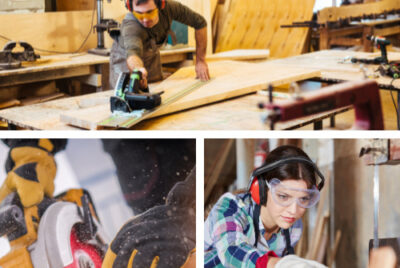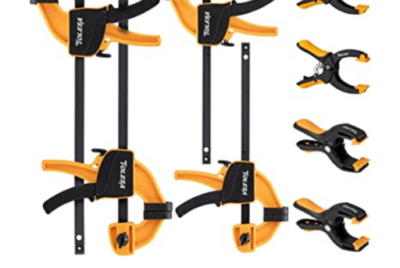10 Essential Woodworking Power Tools
*We may earn a commission for purchases made using our links. Please see our disclosure to learn more.
What Are Woodworking Power Tools?
Woodworking power tools are electrically or battery-powered tools designed to make woodworking tasks more efficient, accurate, and less labor-intensive. These tools can range from handheld devices to large stationary machines, all of which aid in cutting, shaping, drilling, sanding, and joining wood.
Why Are Woodworking Power Tools Essential?
As an avid woodworker, I’ve come to appreciate the importance of woodworking power tools in my craft. They not only save time but also enable me to achieve precision and finesse that would be challenging with hand tools alone. Here, I’ll share my top 10 essential woodworking power tools and why they are vital for any woodworking enthusiast or professional.
10 Essential Woodworking Power Tools

The table saw is the centerpiece of any woodworking shop. Its versatility allows for various cuts, including crosscuts, rips, bevels, and miters. With a sturdy table and a powerful motor, it delivers accurate results for both large sheets and small pieces of wood. A must-have for any serious woodworker.

A power drill is indispensable for boring holes and driving screws. Look for one with adjustable speed and torque settings to handle various drilling tasks. Cordless drills provide more flexibility, while corded ones ensure consistent power for extended work sessions.

For precise angle cuts, a miter saw is unbeatable. Ideal for cutting moldings, trim, and framing materials, it guarantees clean and accurate results. Consider a compound miter saw for bevel cuts, enhancing the tool’s versatility.

A router is essential for decorative edge profiling, joinery, and creating intricate designs on wood surfaces. It comes in both handheld and table-mounted versions, each serving specific purposes. Invest in high-quality bits to unlock the router’s full potential.

The jigsaw is perfect for curved cuts and intricate patterns. It excels in making scrollwork, cutting openings for sinks, and creating artistic designs. Opt for a jigsaw with variable speed control to adapt to different wood densities.

A smooth finish is crucial in woodworking projects, and a random orbital sander achieves just that. Its circular sanding pattern minimizes swirl marks, providing a pristine surface for staining or painting.
Thickness Planer
If you frequently work with rough lumber, a thickness planer is indispensable. It ensures uniform thickness across boards, improving their appearance and enabling seamless joinery.

Handy for cutting large panels and lumber, a circular saw offers portability and maneuverability. Choose one with adjustable depth and bevel settings for added versatility.

The band saw excels in cutting irregular shapes and resawing thick lumber into thinner boards. Its continuous blade allows for intricate cuts and greater control over the material.

For turning wood into beautifully shaped objects like bowls, pens, and spindle legs, a wood lathe is a game-changer. Its rotating motion allows for precise and smooth shaping.
Choosing the Right Woodworking Power Tools
As a fellow woodworker, I understand the importance of selecting the right woodworking power tools for your projects. Here are some crucial factors to consider before making your purchase:
1. Consider Your Woodworking Projects
Every woodworker’s needs vary based on the types of projects they undertake. Assess your woodworking goals and select tools that align with your preferences. For instance, if you focus on intricate designs, a router and jigsaw should be prioritized.
2. Quality and Brand Reputation
Investing in high-quality power tools ensures better performance, longevity, and safety. Research reputable brands known for producing reliable tools, as they are likely to provide a more satisfying woodworking experience.
3. Power and Performance
Choose tools with adequate power for your intended applications. A table saw or thickness planer, for example, demands a robust motor to handle dense hardwoods effectively.
4. Safety Features
Safety should always be a top priority in woodworking. Look for tools equipped with safety features like blade guards, electric brakes, and ergonomic designs to minimize the risk of accidents.
5. Budget
Woodworking power tools can range significantly in price. Set a budget and aim to strike a balance between affordability and quality. Splurging on essential tools can be justified if they meet your long-term needs.
How to Safely Use Woodworking Power Tools
As an enthusiast woodworker, safety should be at the forefront of your mind. Here are some essential tips to follow when using your woodworking power tools:
Read the Manuals
Before operating any tool, read the user manuals thoroughly. Familiarize yourself with the tool’s features, safety guidelines, and maintenance requirements. This knowledge will empower you to use the tool efficiently and safely.
Wear Appropriate Safety Gear
Always wear the necessary safety gear when working with woodworking power tools. This includes safety glasses to protect your eyes from flying debris, ear protection to safeguard against loud noise, and a dust mask to prevent inhalation of harmful particles. Additionally, wear fitted clothing and avoid loose accessories that could get entangled in the tool.
Keep Work Area Clean and Organized
Maintaining a tidy work area is crucial for safety and efficiency. Remove clutter and ensure there are no obstacles that could interfere with your movements while operating the tools. Keep tools properly stored when not in use, reducing the risk of accidental injuries.
Use Proper Techniques
Learn and practice correct techniques for each power tool to ensure precise and safe woodworking. Avoid rushing through tasks and focus on maintaining control over the tool at all times. Seek guidance from experienced woodworkers or take woodworking classes to improve your skills.
Maintaining Woodworking Power Tools
Proper maintenance is essential to extend the life of your woodworking power tools and ensure they perform optimally. Here are some maintenance tips to keep your tools in top shape:
Regular Cleaning
Regularly clean your power tools to remove dust, debris, and residue from cutting or sanding. Dust accumulation can affect the tool’s performance and compromise its safety features. Follow the manufacturer’s guidelines on cleaning and lubricating specific components.
Lubrication and Calibration
Some woodworking power tools require periodic lubrication to ensure smooth operation. Check the user manual for instructions on the appropriate lubricants and calibration procedures. Regular calibration guarantees accurate results and prevents premature wear.
Replacement of Worn Parts
Inspect your power tools frequently and replace any worn or damaged parts promptly. Blades, bits, belts, and other consumables should be replaced at the first signs of wear. Using dull blades or worn-out components can result in unsafe and poor-quality work.
Storage
When not in use, store your power tools in a dry and secure location. Keep them away from moisture and extreme temperatures that could damage electronic components. Invest in tool cases or storage solutions to protect your tools during transportation or extended periods of inactivity.
Tips for Getting the Most Out of Your Woodworking Power Tools
As an enthusiastic woodworker, you want to maximize your creativity and efficiency. Here are some tips to make the most of your woodworking power tools:
1. Measure Twice, Cut Once
Accurate measurements are crucial in woodworking. Double-check your measurements before making any cuts to avoid wastage and mistakes. Investing in quality measuring tools, such as a tape measure and combination square, will aid in precision.
2. Start with Basic Projects
If you’re new to woodworking, begin with simple projects to build your skills and confidence. Practice using your essential power tools on smaller tasks before moving on to more complex endeavors. Gradually challenge yourself to tackle more intricate projects as your expertise grows.
3. Practice and Patience
Woodworking is an art that demands practice and patience. Embrace mistakes as learning opportunities, and don’t be discouraged by initial setbacks. With persistence, your skills will improve, and your creations will reflect your dedication.
4. Use Clamps for Stability
When cutting or shaping wood, use clamps to secure the material firmly in place. This enhances safety and allows for more accurate cuts, as the wood won’t shift during operation.
5. Safety First, Always
Woodworking power tools can be intimidating, especially for beginners. Prioritize safety and never take shortcuts when it comes to protecting yourself. Always wear appropriate safety gear, follow safety guidelines, and work with full focus and attention.
Common Woodworking Power Tool FAQs
As a woodworking enthusiast, you might have some questions about power tools. Here are some common FAQs answered:
Q. Can I Use Cordless Power Tools for Woodworking?
Yes, cordless power tools are suitable for woodworking, especially when mobility is essential. However, consider the battery’s runtime and power output for more demanding tasks. It’s also wise to have spare batteries charged and ready.
Q. What’s the Difference Between a Circular Saw and a Table Saw?
A circular saw is handheld and used for straight cuts on wood, while a table saw is a stationary tool with a blade protruding from a table. Table saws offer greater stability and precision for various cuts, making them a go-to choice for many woodworkers.
Q. Do I Need a Router if I Already Have a Power Drill?
While a power drill can make holes, a router is specialized for decorative edge work, joinery, and intricate designs. If you’re into detailed woodworking projects, a router is an invaluable addition to your toolkit.
Q. Can I Use a Miter Saw to Cut Metal or Plastic?
Miter saws are designed specifically for cutting wood, and attempting to cut metal or plastic could damage the tool or produce inaccurate results. For non-wood materials, use appropriate tools like metal-cutting saws or plastic cutters.
Q. How Often Should I Replace Saw Blades and Bits?
The frequency of blade and bit replacement depends on the type of material you work with and the intensity of usage. Regularly inspect the cutting edges, and replace them when they show signs of dullness or damage to maintain optimal performance and safety.
Conclusion
As an avid woodworker, I can confidently say that having the right woodworking power tools is essential for any woodworking project. These versatile and efficient tools make the craft more enjoyable, allowing you to bring your creative visions to life with precision and finesse. Remember to prioritize safety, invest in quality tools, and continually practice and explore new projects to hone your skills. Whether you’re a hobbyist or a seasoned professional, the right woodworking power tools will undoubtedly enhance your woodworking experience.
In conclusion, woodworking power tools are indispensable for any woodworking enthusiast or professional. From the versatile table saw to the precision of the wood lathe, these tools empower woodworkers to create stunning and intricate projects. Remember to choose the right tools based on your specific woodworking needs and prioritize safety at all times. With practice, patience, and the right tools at your disposal, you can elevate your woodworking skills and embark on an exciting journey of creativity and craftsmanship.




